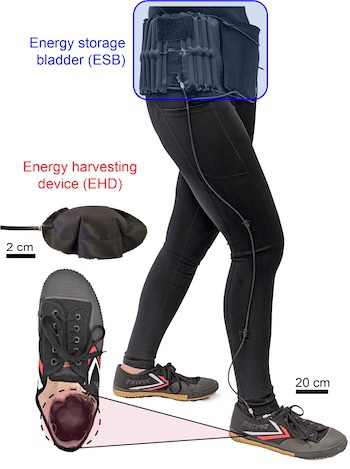Video: Pneumatic assistive tech device could help people with reduced mobility
Mechanical engineers at Rice University’s George R. Brown School of Engineering in the US have built an assistive “handy extra limb” able to grasp objects and go, powered only by compressed air.
It is one of several ideas the engineers implemented with a textile-based energy harvesting system.
The proof-of-principle robotic devices designed and built by Daniel Preston, Assistant Professor of Mechanical Engineering, the lead authors, Rachel Shveda and Anoop Rajappan, and their team are geared around those living with disabilities and are tough enough for everyday use, they said.
People with mobility impairments may experience stiffness or spasticity, as well as loss of muscle strength. According to Statistica, 42 percent of working adults, 63 percent of state pension age adults, and 15 percent of children in the UK have a mobility disability.
A pneumatic device is a tool or instrument that generates and utilises compressed air. The pneumatic devices derive their power from walking. Created using only textiles and open cell lightweight foam to build a system that every time your foot strikes the ground during transfers the pressure to a wearable belt worn around the waist for later use in the assistive actuators.
The prototype “arm” is a piece of fabric that hugs the body when not in use but extends outward when activated and incorporates an elastomer lining on the surface to maintain its grip on slippery objects.
The device wraps around the lower abdomen with a thin tube trailing down the leg to the foot where the energy harvesting device sits in the users shoe.
For demonstrations, an officer in the US Coast Guard would operate the arm with a switch. Daniel said future versions could have sensors that anticipate the wearer’s intent and complete the movement. Daniel also noted that conversations with fashion consultants could be featured in the devices’ future.
In addition to the curling arm that can grip a cup or other small objects while a person’s hands are full, the Rice lab built a shirt with a bellows-like actuator attached at the armpit that expands, enabling the wearer to pick up a 4.5 kg object. Testing the products on a mannequin showed that this could be done without an assist from human muscles, according to the researchers.
The system requires two components: textile pumps embedded in the soles of walking shoes that harvest air pressure and pneumatic actuators that make use of that pressure where needed. The pumps are filled with open-cell polyurethane foam that allows them to recover their shape after every footfall.
Daniel said the pump is small enough to be comfortable: “The stiffness of the foam is about on par with a typical shoe insert.” He said, “We wanted to make sure this felt like something you’d actually want to have inside of your shoe.”
Tests by the Rice Lab showed the devices produce the equivalent of three watts of power with a conversion efficiency of more than 20 percent.
Daniel said all the components for a single device cost the lab $20, less than £20. The products were simple to assemble and robust enough to clean in a washing machine with no degradation in performance.
“The fabrication approach uses techniques that are already employed in the garment industry, things like cutting textile sheets and bonding them with heat and pressure,” he added.
“We’re ready to think about translating our work towards products.”
Anoop explained that along with test units, the lab also developed mathematical models to predict how well an assistive device would perform based on a user’s weight and walking speed, among other parameters.
“One way to take this forward will be to use the model to optimise performance for specific user groups,” he said. “We’re also thinking about devices like pneumatic actuators that apply therapeutic compression for things like deep vein thrombosis, blood clots in the legs. Anything that requires air pressure can be powered by our system.”
Daniel concluded: “Now that we’re providing the power, we can tap into all the existing work on actuation.
“This would include things like gloves that help people close their hands, assistance at both the elbow and shoulder joints and other devices that still rely on typically rigid and bulky power supplies that are either uncomfortable or require being tethered to external infrastructure.”



